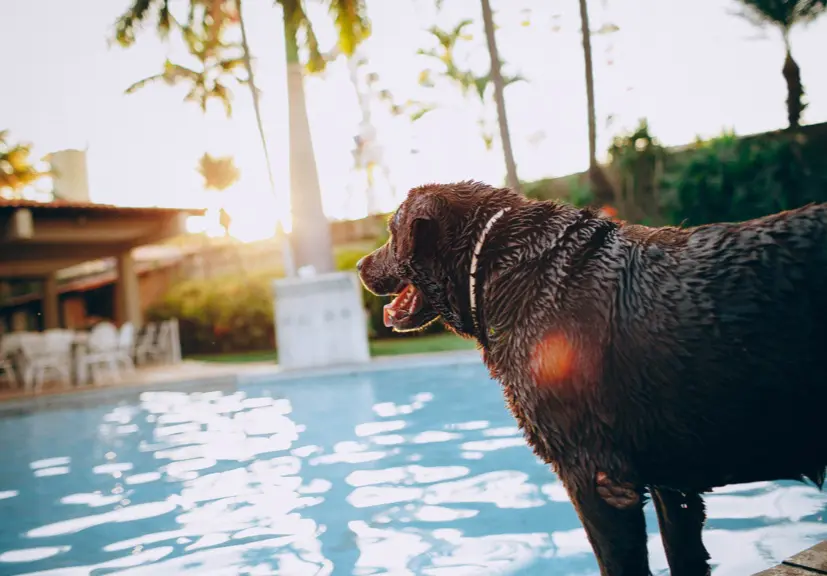Is swimming pool safe for the pets? This is an important question for every pet owner who loves spending timer near water with their furry companions.
The pool is a great place for your family and pets to spend their summers. It’s the perfect solution to cooling down, soaking up some sun, and having lots of fun. However, like with small children, your dog can potentially be at risk of getting hurt if not properly supervised. Not all dogs are great swimmers and not all pools are considered dog friendly.
Rule number one for pet pool safety is to never leave your pet unattended around a pool. This has the potential to be a very dangerous situation. If you are aware that your dog is not a great swimmer, then invest in a life jacket to improve buoyancy. This will keep your dog more visible if it is small and can provide an extra bit of safety. You should never just assume that all dogs can swim. Some dogs need to be trained to swim while some are naturals and for others it’s nearly impossible.
Rule number one for pet pool safety is to never leave your pet unattended around a pool

Recognize which category your dog falls under early on and be sure to take the proper precautions to guarantee its health and safety and to avoid the potential of drowning. Also, if your dog is older or has an injury like arthritis, it would be beneficial to make sure it has a vest. Dogs must be introduced to water properly before they can begin to have fun. Pets are easily irritated by chlorine. Like humans their eyes and skin can get potentially aggravated if proper steps are not taken. Make sure you wash your dog off with fresh water to avoid skin irritation and damage to your home when the dog re-enters the house. Even though it may be tempting, refrain from allowing your dog to drink the pool water.
In this blog post, we’ll explore:
- The potential dangers of pools for pets
- How to make your pool pet-friendly
- Signs of water-related distress in pets
- Alternatives to traditional pools for your furry companions
1. Chlorine and chemicals
The chlorine and chemicals used in the pool will cause your dog to become sick with health problems such as dry mouth or gastric distress, which is no fun for anyone. Many of these same precautions and tips apply to ponds, rivers, and lakes as well. Although they are declared to be safer for dogs because they have better exits and a lack of chemicals, these places can also be harmful. Do not let your dog consume pond, puddle, or lake water. These areas are a common source of parasites that cause gastrointestinal issues that can also be passed on to other members of your family.
Solution: Rinse your pet with fresh water after swimming and provide clean drinking water to discourage them from lapping up pool water.
2. Risk of Drowning
Not all pets are strong swimmers. Even breeds known for their swimming abilities (like Labradors) can tire quickly or panic in the water. Pets with short legs (like Bulldogs or Dachshunds) may struggle to stay afloat.
- Exhaustion: Swimming is physically demanding, and pets can tire faster than humans.
- No Exit: If your pet can’t find the pool steps or ramp, they may become trapped.
Solution: Always supervise your pet in the water and consider installing a pet-friendly ramp or steps.
3. Ear and Respiratory Infections
Water trapped in a dog’s ears can lead to painful ear infections, especially in breeds with floppy ears (like Cocker Spaniels). Additionally, inhaling pool water can cause aspiration pneumonia.
Solution: Dry your pet’s ears thoroughly after swimming and consider using a vet-approved ear cleaner.
4. Slippery Surfaces and Injuries
Wet pool decks can be slippery, increasing the risk of falls and joint injuries, especially for older pets.
Solution: Use non-slip mats around the pool area to provide better traction.
Signs Your Pet Is in Trouble
Even with precautions, accidents can happen. Watch for these warning signs:
Even strong swimmers can benefit from a well-fitted life jacket, especially in deep water or during boat rides.
- Excessive panting or fatigue
- Coughing or gagging (signs of water inhalation)
- Struggling to stay afloat
- Disorientation or lethargy after swimming
If you notice any of these symptoms, remove your pet from the water immediately and consult a vet if necessary.
“Not all dogs are great swimmers and not all pools are considered dog friendly.”




